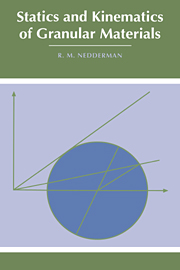Book contents
- Frontmatter
- Contents
- Notation
- 1 Introduction
- 2 The analysis of stress and strain rate
- 3 The ideal Coulomb material
- 4 Coulomb's method of wedges
- 5 The method of differential slices
- 6 Determination of physical properties
- 7 Exact stress analyses
- 8 Velocity distributions
- 9 The Conical yield function
- 10 The prediction of mass flow rate
- Set problems – chapters 2–10
- Appendices
- References and bibliography
- Index
10 - The prediction of mass flow rate
Published online by Cambridge University Press: 28 October 2009
- Frontmatter
- Contents
- Notation
- 1 Introduction
- 2 The analysis of stress and strain rate
- 3 The ideal Coulomb material
- 4 Coulomb's method of wedges
- 5 The method of differential slices
- 6 Determination of physical properties
- 7 Exact stress analyses
- 8 Velocity distributions
- 9 The Conical yield function
- 10 The prediction of mass flow rate
- Set problems – chapters 2–10
- Appendices
- References and bibliography
- Index
Summary
Introduction
In this final chapter we will consider the discharge rate of granular materials through orifices. In §10.2 we will review the correlations that have been proposed, paying particular attention to the Beverloo correlation and minor modifications to it. In §10.3 we will present the early theoretical attempts at the prediction of mass flow rate and discuss the validity of the ‘free-fall arch’, which forms the basis of most of these predictions. We will then consider in §10.4 and §10.5 some more recent theoretical approaches based on the so-called Hour-Glass Theory. The effect of interstitial pressure gradient on the flow rate is discussed in §10.6 and this leads on to consideration of the problems associated with the flow of fine powders in §10.7. Finally in §10.8 and §10.9 we will consider two notorious difficulties associated with discharge from hoppers, the problems of arching and flooding. The former can prevent discharge and the latter gives very large and often uncontrollable flow rates.
It may be noted that in the theoretical sections of this chapter, we are departing for the first time from the subject matter implied by the title of this book, since we are now considering dynamics, the effect of forces on the acceleration of the material.
Mass flow rate correlations
Figure 10.1 shows a schematic representation of both a cylindrical bunker and a conical hopper to define the terminology of this chapter.
- Type
- Chapter
- Information
- Statics and Kinematics of Granular Materials , pp. 292 - 328Publisher: Cambridge University PressPrint publication year: 1992
- 1
- Cited by

